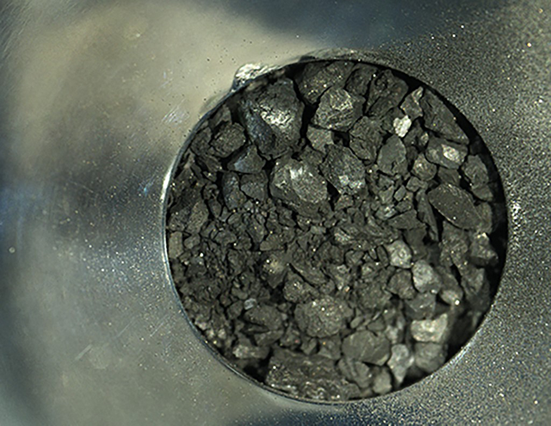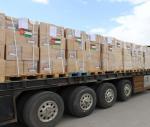You are here
Major asteroid sample brought to Earth in NASA first
By AFP - Sep 27,2023 - Last updated at Sep 27,2023

This shot off a NASA live feed shows NASA safety team members prepare the Osiris-Rex asteroid sample return craft sitting in the Utah desert at Dugway, Utah, on Sunday (AFP photo)
DUGWAY, United States — A seven-year space voyage came to its climactic end on Sunday when a NASA capsule landed in the desert in the US state of Utah, carrying to Earth the largest asteroid samples ever collected.
Scientists have high hopes for the sample, saying it will provide a better understanding of the formation of our solar system and how Earth became habitable.
When they learned that the capsule's main parachute had deployed, "I literally broke into tears," the Osiris-Rex mission's principal investigator Dante Lauretta told a press conference.
"That was the moment I knew we made it home... For me the real science is just beginning."
The 6.21-billion-kilometre journey marked the United States' first sample return mission of its kind, the US space agency said in a post on X, formerly Twitter.
NASA chief Bill Nelson hailed the mission and said the asteroid dust "will give scientists an extraordinary glimpse into the beginnings of our solar system".
The Osiris-Rex probe's final, fiery descent through Earth's atmosphere was perilous, but NASA managed to engineer a soft landing at 8:52 am local time (14:52 GMT), in the military's Utah Test and Training Range.
Four years after its 2016 launch, the probe had landed on the asteroid Bennu and collected what NASA estimated is roughly 250 grammes of dust from its rocky surface.
Even that small amount, NASA says, should "help us better understand the types of asteroids that could threaten Earth".
The sample return "is really historic", NASA scientist Amy Simon told AFP. "This is going to be the biggest sample we've brought back since the Apollo moon rocks" were returned to Earth.
Osiris-Rex released its capsule early Sunday from an altitude of more than 107, 826.05 kilometres.
The fiery passage through the atmosphere came only in the last 13 minutes, as the capsule hurtled downward at a speed of more than 43,452 per hour, with temperatures of up to 2,760ºC.
NASA images showed the tire-sized capsule on the ground in a desert wash, with scientists approaching the device and taking readings.
Eventually they concluded the capsule was not breached, meaning its all-important air-tight seal remained intact, avoiding any contamination of the sample with desert sands.
The team then lifted the capsule by helicopter to a nearby "clean room".
Meanwhile, the probe that made the space journey fired its engines and shifted course away from Earth, NASA said, "on its way" for a date with another asteroid.
Japanese samples
On Monday, the sample heads to Johnson Space Centre in Houston for additional study, and NASA plans to announce its first results at a news conference October 11.
Roughly one-fourth of the sample will be immediately used in experiments, and a small amount will be sent to mission partners Japan and Canada.
But most of it will be saved for future generations — a "treasure for scientific analysis for years and years and years to come, to our kids and grandkids and people that haven't even been born yet", Lori Glaze, director of NASA's Planetary Sciences division, said.
Japan had earlier given NASA a few grains from asteroid Ryugu, after bringing 5.6 grammes of dust to Earth in 2020 during the Hayabusa-2 mission. Ten years before, it had brought back a microscopic quantity from another asteroid.
But the sample from Bennu is much larger, allowing for significantly more testing, Simon said.
Earth's origin story
Asteroids are composed of the original materials of the solar system, dating back some 4.5 billion years, and have remained relatively intact.
They "can give us clues about how the solar system formed and evolved", said Osiris-Rex programme executive Melissa Morris.
"It's our own origin story."
By striking Earth's surface, "we do believe asteroids and comets delivered organic material, potentially water, that helped life flourish here on Earth", Simon said.
Scientists believe Bennu, about 500 metres in diameter, is rich in carbon — a building block of life on Earth — and contains water molecules locked in minerals.
Bennu surprised scientists in 2020 when the probe, during its brief contact with the asteroid's surface, sank into the soil, revealing an unexpectedly low density, like a children's pool filled with plastic balls.
Understanding its composition could come in handy, for there is a slight — but non-zero — chance (one in 2,700) that Bennu could collide catastrophically with Earth, though not until 2182.
NASA last year successfully deviated the course of an asteroid by crashing a probe into it in a test, and it might at some point need to repeat that exercise — but with much higher stakes.
Related Articles
HOUSTON — A sample collected from the 4.5-billion-year-old asteroid Bennu contains abundant water and carbon, NASA revealed on Wednesday, of
TOKYO — The black particles from an asteroid some 300 million kilometres away look unremarkable, like pieces of charcoal, but they hol
TOKYO — Japan space agency officials on Sunday hailed the arrival of rare asteroid samples on Earth after they were collected by space probe

















